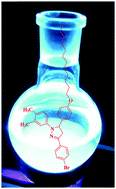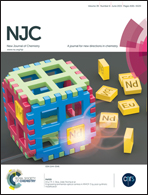Structure-fluorescence relationship: interplay of non-covalent interactions in homologous 1,3,5-triaryl-2-pyrazolines†
Abstract
Fluorescence intensity depends on the synergy of multiple non-covalent interactions in solutions. Twelve new homologous 1,3,5-triaryl-2-pyrazolines (1–12)·Br have been synthesized and characterized on the basis of their spectral (IR, 1H and 13C NMR and MS) and microanalytical data to investigate the interplay of non-covalent interactions and their effect on absorption and fluorescence properties by UV-vis and emission spectroscopies. All the compounds showed fluorescence in the blue region of the visible spectrum, but a strong influence of alkyloxy chain length was observed on the emission intensity without causing any major blue- or red-shifts in the emission wavelengths. The absorption and emission maxima (λabsmax and λemmax) for all the compounds were observed in the range of 404–414 nm and 467–479 nm, respectively. Compound 12·Br showed the maximum emission intensity, indicating the dominant role of weak van der Waals forces in driving the solution state self-assembly in comparison to other relatively strong intermolecular interactions. The influence of different halogen substituents present on the conjugated backbone of the 1,3,5-triaryl-2-pyrazoline skeleton in relation to the increasing alkyloxy chain length and their ultimate role in driving the solution state self-assembly and fluorescence properties are also discussed.


 Please wait while we load your content...
Please wait while we load your content...